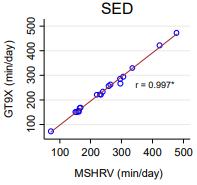The mDOT Center
Transforming health and wellness via temporally-precise mHealth interventions






mDOT@MD2K.org
901.678.1526
901.678.1526








Collaborating Investigator:
Neng Wan, The University of Utah
Funding Status:
NIH/NCI
08/09/23 – 06/30/28
Associated with:

Sensors (Basel)
MotionSense HRV, accelerometer, mobile health, physical activity, sedentary behavior
February 18, 2021
MotionSense HRV is a wrist-worn accelerometery-based sensor that is paired with a smartphone and is thus capable of measuring the intensity, duration, and frequency of physical activity (PA). However, little information is available on the validity of the MotionSense HRV. Therefore, the purpose of this study was to assess the concurrent validity of the MotionSense HRV in estimating sedentary behavior (SED) and PA. A total of 20 healthy adults (age: 32.5 ± 15.1 years) wore the MotionSense HRV and ActiGraph GT9X accelerometer (GT9X) on their non-dominant wrist for seven consecutive days during free-living conditions. Raw acceleration data from the devices were summarized into average time (min/day) spent in SED and moderate-to-vigorous PA (MVPA). Additionally, using the Cosemed K5 indirect calorimetry system (K5) as a criterion measure, the validity of the MotionSense HRV was examined in simulated free-living conditions. Pearson correlations, mean absolute percent errors (MAPE), Bland-Altman (BA) plots, and equivalence tests were used to examine the validity of the MotionSense HRV against criterion measures. The correlations between the MotionSense HRV and GT9X were high and the MAPE were low for both the SED (r = 0.99, MAPE = 2.4%) and MVPA (r = 0.97, MAPE = 9.1%) estimates under free-living conditions. BA plots illustrated that there was no systematic bias between the MotionSense HRV and criterion measures. The estimates of SED and MVPA from the MotionSense HRV were significantly equivalent to those from the GT9X; the equivalence zones were set at 16.5% for SED and 29% for MVPA. The estimates of SED and PA from the MotionSense HRV were less comparable when compared with those from the K5. The MotionSense HRV yielded comparable estimates for SED and PA when compared with the GT9X accelerometer under free-living conditions. We confirmed the promising application of the MotionSense HRV for monitoring PA patterns for practical and research purposes.
The purpose of this study was to assess the concurrent validity of the MotionSense HRV in estimating sedentary behavior (SED) and PA.
This project focuses on understanding how neighborhood environments, individual factors, and social history influence physical activity (PA) adoption and maintenance among sedentary Pacific Islander adults in Utah who experience significant health disparities.
This project will explore how neighborhood environments, individual factors, and social history impact physical activity (PA) adoption and maintenance among sedentary Pacific Islander adults in Utah. Pacific Islanders suffer from disparities in a variety of health problems such as obesity, cardiovascular diseases, diabetes, and cancer at several sites. Although physical activity is an effective way to reduce the risks of these health problems, Pacific Islander adults are generally less physically activity than non-Hispanic whites. The search for effective policies and interventions to promote PA among Pacific Islanders is severely hampered by the paucity of research on the mechanisms underlying PA behavioral change in this population. This Study will leverage mobile health technologies to capture PA and its key influences in real-time, addressing a critical gap in understanding PA behavior change within this high-risk, understudied population. The study aims to provide valuable insights into improving PA levels and reducing obesity and related health issues in this group. Additionally, the methodology and findings will offer broader perspectives on PA behavior for other racial/ethnic groups with high obesity and low PA levels.
CP12 utilizes MotionSense wrist bands from TR&D3 researchers have collaborated to develop an optimized version of the MotionSense activity band.
CP12 challenges TR&D3 in developing a self-contained version of MotionSense that implements computationally efficient micromarkers for real-time PA assessment and heart rate variability (HRV).
CP12 can collect PA in a multi-week study without a need for Internet connectivity together with raw data for extensive post-analysis, making it suitable for rural/remote populations.
This study is guided by an overarching conceptual framework derived from models of the social/environmental determinants of health, social cognitive theories of behavioral change, and prior empirical findings. Participants will be assessed using real-time, field-based, state of the art methodologies consisting of MotionSense, ecological momentary assessment, and GPS. MotionSense track behavioral and physiologic data in real-time and can objectively detect PA behaviors and negative affect/stress of participants.
MotionSense sensor hardware and firmware is developed by TR&D3 researchers. Working in tandem with the project team, we have developed a version of the activity band that can store all the raw data for the study to enable a diverse set of post data analyses. In addition, in alignment of TR&D3 Aim 1, we have developed computationally efficient micromarker implementations of Physical activity measures. This allow the band in real-time assess physical activity and trigger EMAs at the mobile phone when moderate sustained activity is detected. Part of the project we will work in extending real-time measures of stress and arousal using heart rate variability metrics. This effort will significantly rely on using autoencoder structures optimized for the embedded hardware of MotionSense band, that gleans information from the raw PPG measures to create micromarkers from which HRV measures can be derived at the mobile phone. Implementing and validating of these real-time HRV measures against the post-processed PPG data will further our goals under Aim 1 of TR&D3. This collaboration has the potential to synergistically enhance both TR&D3’s as well as this Projects aims.
You must be logged in to post a comment.

No Comments